
Coming up with a list of the 'best' has felt desperate, with this in mind I'm afraid I make reference to lots of other routes around this grade which could have been in here whilst telling a little about the routes I decided on. The list goes from North to South more or less. At this grade there are many chop routes, but I've left them out and the ones I make mention of are primarily well protected at the grade and a lot of fun.
Also in this series:
- The Five Best HVS Routes in the UK?
- The Five Best E1 Routes in the UK?
- The Five Best E2 Routes in the UK?
- The Five Best E4 Routes in the UK?
- The Five Best E5 Routes in the UK?
Longhope Route (E7 6c) (Arran/Turnbull), St Johns Head, Hoy. E7 6c. 500 metres
Most of the ones I've chosen are single pitch so I thought I'd make up for it by chucking this one in. The journey to Hoy is a pleasure made by most UK adventure climbers at some point to climb the brilliant Old Man of Hoy and the ferry journey between Scrabster and Stromness on the Hamnavoe gives a good view of the Old Man, Rora Head and the daunting face of St John's Head. St John's Head appears to be a huge concave wall with a ships prow at the top supplying the steepest, hardest pitches.
Ed Drummond and Oliver Hill climbed the original line on the wall, big wall style, spending a week on the face in the 1970s. The Turnbull/Arran route was set in the 1990s and tackles the majority of this line with a deviation high up missing out Dave Macleod's hard direct before joining it for the ace finish up a finger crack in one of the most exposed positions in Britain, with 100s of feet of seagulls wheeling about beneath you.
Thankfully none of the individual pitches on it would warrant E7 with the hardest pitch being easy to aid, but an early start, experience at climbing rapidly on the odd bit of loose rock and not being squeamish about fulmar vomit are all handy qualities for a successful outcome. A headtorch should be carried just in case. The consequences of failing to achieve the summit were shown by Alex Mason's and George Ullrich's attempt in 2013 where they were forced into an epic escape leftwards into the 'green bowels' of St John's Head. They've never been the same since.
Dalriada (E7 6b), The Cobbler, Arrochar Alps. E7 6b
This one was the easy one to choose. The ludicrously exposed position on the top of the Cobbler's north peak make it one of the more 'out there' routes to be found. It was first ascended by Gary Latter who has helped promote Scotlands climbing through his 2 excellent guidebook volumes. There have been numerous inspiring pictures of repeat ascentionists over the years although I think Cubby's one of Dave Macleod on the rest before the top headwall may be the finest.
It climbs as a slightly pumpy arête to a rest beneath the crux roof, blind moves left here lead to a crack, good jugs and a rest beneath the technical final headwall. I'd wanted to do it since the late 1990s and had attempted to get to the cliff 3 times in the last decade being rained on each time.
Last August it was pissing down again the morning myself and Sophie met up with Dan Varian, Kevin Avery and Micky Stainthorpe in the car park at the base of the Cobbler. Dan Varian was still psyched so we walked through the rain to the cliff. It stopped as we arrived and I had a hard time on the still slippery E2 Club Crack. The clouds cleared and we could see the amazing line of Dalriada to our right. It looked dry enough and before long me, Dan and Kev had all made an ascent. It climbed as well as it looked and was well worth the numerous attempts in inclement conditions to get to it. It was originally graded E8 6b which interestingly enough is the grade it will go to if the pegs on the headwall disappear. In its current form it's a very safe but intimidating and tricky to onsight 7b+ which should definitely be on every aspiring E7 leader's radar. Get it done while the pegs are still good.
Dusk till Dawn (E7 6b), Dove Crag, Ullswater, Lake District. E7 6c
Al Wilsons creation and a strong contender for the best E7 pitch in Britain. Dove crag itself is the best cliff in the lakes for people wanting to head up classic E5s, 6s-7s being gently overhanging for 30m, having generally good protection and positive holds it's the 'trad crag for the sport climber'. The popular bivvy cave - the Priest's Hole - lies right above the main face of Dove.
I climbed a great deal with Al Wilson in 1998 when Al was pretending to still work at Sellafield and I was pretending to do A-levels. Living in Wales from the end of 2002 I unfortunately missed out the re-developments of Dove Crag which occurred around this time helped spurred on by Al and his brush. When he did Dusk Till Dawn he spoke about it with awe as did Chris Hope and many of the local climbers. It covers very unlikely ground on the main face using the start of Bucket Dynasty and cutting through Vlad the Impailer to gain a very steep and exposed pillar of rock visible from the campsite 2 miles away.
I'd been meaning to get up to try it for years and in 2014 I was back at the base with Emma Twyford who was the person I was last there with over a decade before. We warmed up on a dusty E5 arete called the Outside Edge which has a boulder problem in a wild position. Next up was Dusk Till Dawn but having climbed Bucket Dynasty to the cam 3 slot I realised the description was wrong and the traverse was 2/3 metres lower than where I'd climbed to. Having a flash pump I carried on up. Abseiling down to strip the gear I was able to appreciate how good the climbing and rock quality was on it (I was too absorbed whilst on it). Emma made a very convincing flash of Bucket Dynasty which incidentally has a slightly reachy and powerful crux with a frantic cam placement required ¾ of the way through it. This route originally got E6 but would be quite chunky for that. Dougie Hall onsighted it back in the 1980s, when very few of this standard were being done in this style. Feeling a bit knackered I was also loath to go without trying Al's route as opportunities for Dove are the same as Scafell, often rare.
Re-climbing Bucket Dynasty's crux and stepping right along Vlad I yomped up the huge pillar on jugs to where they disappear 2 moves beneath a peg. At this point I advise people to have a cam 1 ready to protect the next moves as a cam half doesn't fit nor does the cam 1.5! After the peg is clipped a brilliant chuck left for a sinker leaves a still testing finish. If it was fully bolted it would be a renowned 5 star 7c. Being slightly runout between good protection in a brilliant location overlooking Dovedale this climb deserves a lot of attention. Very good find there Al.
The Clown (E7 6b), North Stack, Gogarth, Wales. E7 6b
The best of the E7s on North Stack wall and its safest. It's the counter diagonal to its near terminal precursor The Bells the Bells having considerably harder climbing and thankfully pretty good protection, certainly where you need it. The Cad and the Bells the Bells are the 2 most famous climbs here although Talking Heads and Not Fade Away deserve more attention having some of the best rock and gear.
Gogarth itself is full of good Precambrian quartzite with most climbs offering solid rock with great protection although some stories would have you believe otherwise. North Stack is one of the main exceptions to the rule with the Red Wall area being the other.
Abseiling into North Stack should normally involve a bit of worry, most climbs down there are serious propositions with often big runouts above dubious kit with technical climbing on small flakes which have been known to snap. It's quite a unique experience. Parliament house cave attaches to the right hand side of the face and adds to the daunting atmosphere.
Looking through the guide you'll notice nowhere else on gogarth with so many E6s and 7s in such close proximity. I've not heard of any fatalities here but Nick Bullock has used up a couple of his lives on this wall and it's not a place for your first trad lead fall. Nevertheless the routes on here are fantastic for their genre of soulful trips...
North Wales isn't short of amazing E7s. Heart of Stone, Kaya, Strawberries, The Mad Brown, Isis is Angry, Box of Blood and BamBam could all be on here as well all offering considerably different climbing styles and challenges. The history of the climb is part of it though and the first ascentionist was of course John Redhead, the man who helped deliver perhaps the first E7 and 8 to Britain and who helped make North Stack what it is. It was put up in 1984 and even nowadays with modern equipment it still encompasses the big lead feel on a style of climbing which people struggle on much more now the brick edge training walls have disappeared.
All the climbs on this section of wall have a serious feel about them and on Noel Craine's ascent of The Clown more than one tidal cycle was known to pass. The first roof has good pro (cam 1.5) but has shut down some exceedingly strong performers. The style of climbing after the roof gives the usual gogarth teetering left on positive holds between the green Mariners Lichen leading into the good gear on the Cad and a brilliant finshing sequence high on the left. The final wall is protected by the same thread as protects the Cad which must be pretty good as a flying Lancastrian tested it from the final moves of the Cad in 2006. I did this one in 2002 with Wez after T-rex and we found them comparable in difficulty as T-rex was damp and we were lacking in big pro.
Always the Sun (E7 6b), Stackpole, Pembroke. E7 6c

The walk out to Stackpole is a real treat going via the Lily ponds and tracking the coast to just beyond Mowing Ward. When you look down on this arête it looks terrifying and when you start abseiling into Stackpole you realise the cliff is a hell of a lot bigger than it looks from above. The old cover shot of the CC guidebooks is the possible creator of Always the Sun, the unstoppable Gary Gibson. Steve Mayers had told Pete Robins and I stories about how incredible the climb was and we duly had a weekend trip in 2008 specifically to do this route.
When we arrived in the morning it appeared piss wet through. We warmed up on Gun Cliff with Pete saying I should do some grim looking E5 6b to get going, it was obviously a sandbag and I suggested he did the one next to it instead. This was also a sandbag which got Pete's elbows out but was a good warm up to 2nd. Arriving back at the arête it was dry but stood at the base it still looked intimidating. The crux moves come half way up, thankfully above a bomber wire backing up the in-situ stuff, clamped onto the arête, au cheval you have to limpet up for holds in a break where a peg can be clipped and one more techy move leads to an easy finish so long as the exposure didn't kill you lower down. We finished on some more E5s and did Ghost Train and Terminal Twilight the day after which was another strong contender for one of the 5.
Some glaring omissions which nearly made it in were: The Scoop, The Chisel, Borderline, Sunburst, Flying Dutchman, Heart of Stone, Realm of the Senses, Box of Blood, Point Blank/Nightflight, Charon, Heinious Flytrap, Dusk Till Dawn (Huntsmans), The Marksman and one that myself and Pat Littlejohn thought to be E7, Watching the Ocean (although Neil and Dan say nay but they both backed off it first time and I'm not taking excuses about 'damp'). I'm afraid Masters Edge and Eye of the Tiger don't cut the mustard for this kind of list - too damn small!
About the author...




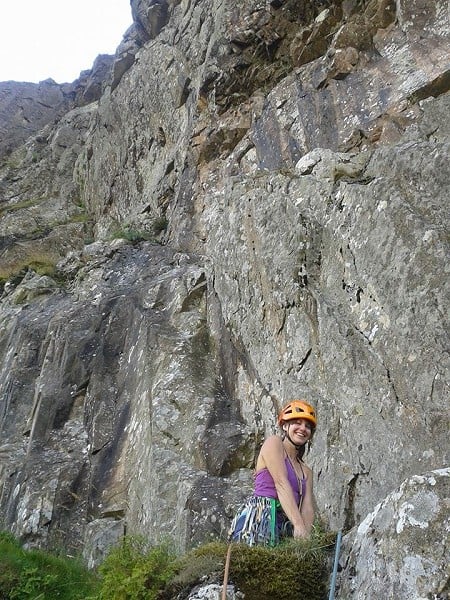
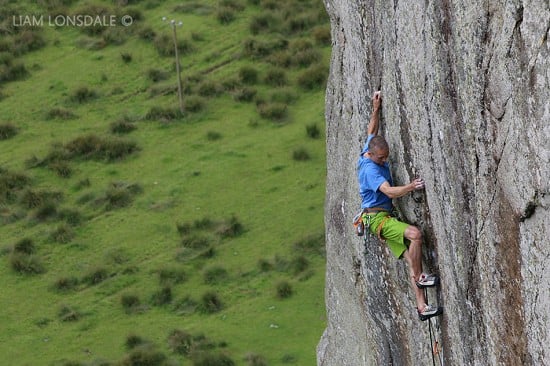









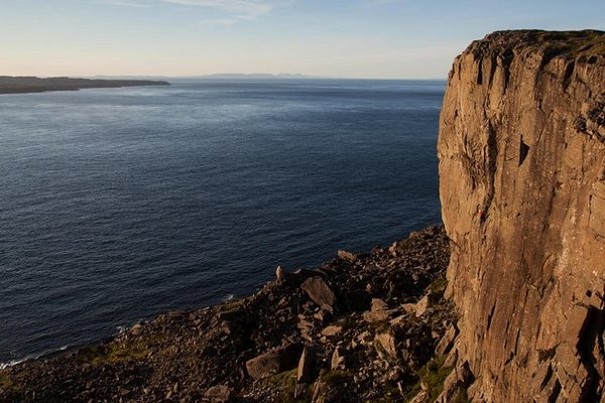
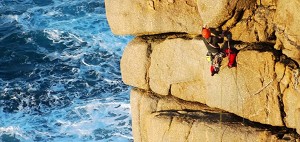

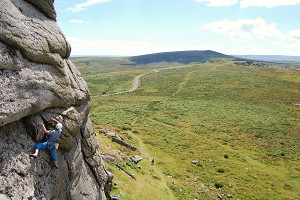
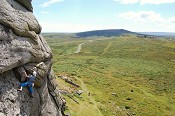
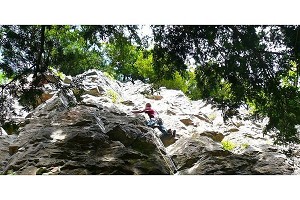
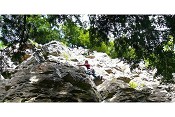
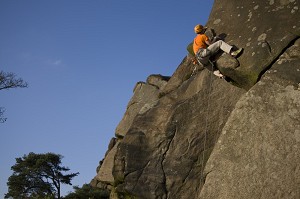
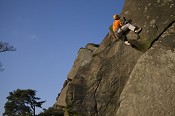
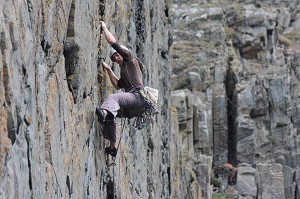
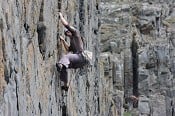
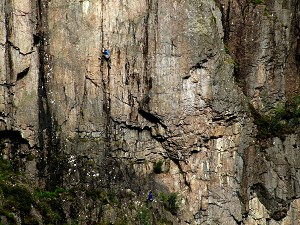
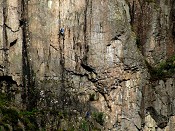
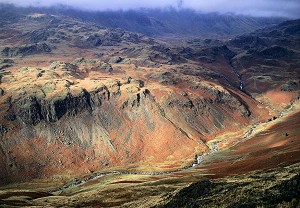

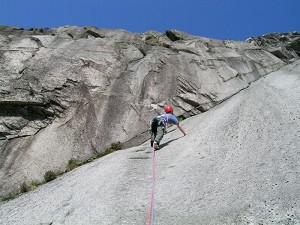
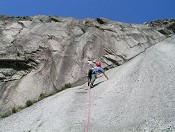
Comments